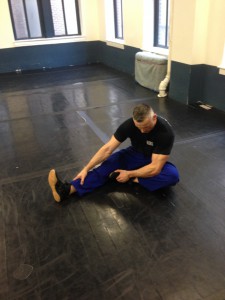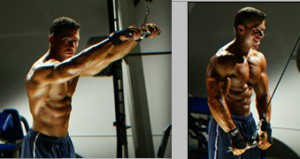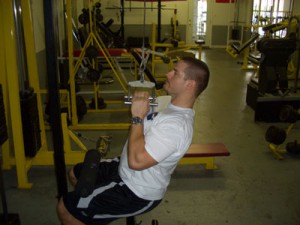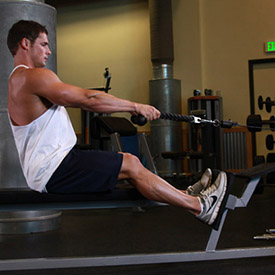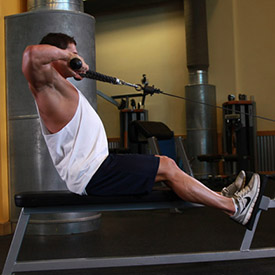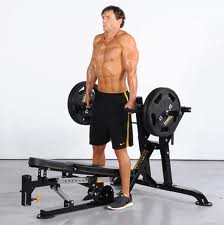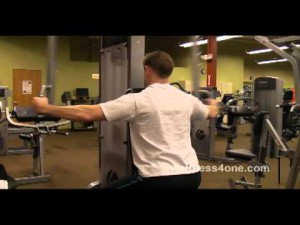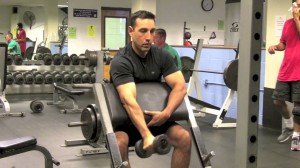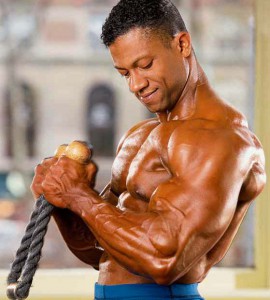Welcome back kids.
All right, I won’t bog you down with a bunch of unnecessary exposition — here’s the third day of my big, fat workout. I’ll include notes on the exercises as well as technique cues, where applicable.
Someone emailed me — I do give out free advice ya know; see the Contact page — asking how often I practice Krav Maga. The answer is anywhere from 4-5 times a week, although I’ll be dropping down to 3 times as my calories (and energy) gets lower.
My classes are only an hour long — a far cry from the 2 1/2 hour MMA classes I used to take — but the pace is high and I always leave feeling wiped.
Now I could probably survive 5 classes and still do 5 weight training workouts on limited calories, but with age comes wisdom. And the goal of any training program, be it fat loss or muscle gain or athletic performance — should never be to see how much exercise you can handle. It should be to perform the right amount of exercise to elicit an adaptation and still recover.
In other words, at a certain point, more isn’t better.
A) Stiff Arm Pulldown — 4 x 8-12
Because this is primarily a hypertrophy and body composition program, I do this movement first to “wake up” the lats and upper back. Often when I do pull-ups first (especially weighted) I can get caught up in completing the reps “at any cost,” namely using the biceps (and momentum). Doing this exercise first gets the lats engaged and ready to work.
I make sure to get a full stretch at the top and hold for a 1-second contraction at the bottom.
B) Neutral Grip Pulldown with Extra Stretch — 4 x 10-12
I know, I know chin-ups are better than pulldowns. They challenge more motor units, work the stabilizer and scapula retractors more, and are more “functional.” I basically agree, and I make sure to do a lot of chin-ups during strength training phases.
However, the beauty of pulldowns is you’re not forced to use your entire bodyweight as resistance, which is useful when trying to do more reps and achieve a longer time under tension. I accentuate the stretch at the top, letting my shoulders extend fully, and pull to about mid chest and hold for a one-count.
C) Dumbbell Rows — Elbows Wide, Scapula Retraction — 4 x 6-8
I cycle through about a dozen dumbbell row variations depending on my goals and needs at the time. In this version, set up as you would for a typical dumbbell row except start every rep with a pronounced scapula retraction (contract the shoulder blade) and then row the dumbbell up in a wide arc — basically imagine you’re elbowing an imaginary friend looming over your shoulder in the nose. Hold the dumbbell in this top position for a one-count and then lower to the floor.
The beauty of this variation is it smokes my lats and scapula retractors without much weight. The drawback is I can’t use the 150-pound dumbbells. Oh well.
D) High Row to Neck — 3 x 8-12
This is one of my favourites. The key here is to keep the elbows high and to use a slow, deliberate tempo and not much weight. Think about pulling the ends of the rope apart as opposed to pulling back and hold for a one-count.
E) Machine Shrugs — 4 x 10-15
I don’t like shrugs, though I do like the trap-3 raise when I remember to program them. More on that lift later. Still, The Rock loves shrugs and I think the Rock is dope. So I do my shrugs. Hold for one second at the top and don’t extend the head too much.
F) Reverse Pec Deck — 2 x 50
The key to rear deltoid hypertrophy is to train them often and for reps, and to use proper technique of course. 90% of the rear delt training I see is really just piss-poor lat work.
Keep the elbows high, retract the scapula, and hold for a strong one-count at the top. Take the sets well into the “Pain Zone” — not to be confused with the Danger Zone, though one might assume that the Pain Zone is also accessible by highway, and by Kenny Loggins.
G) Single-arm, Off Set DB Scott Zottmann Curls — 4 x 8
How’s that for a complicated name? I stole these from a Charles Poliquin video and instantly fell in love (with the exercise, not Charles).
Single-arm means you do one arm at a time. Off set means you hold the dumbbell off center, so the pinky finger is resting against the inside of the plate. This preferentially recruits the short head of the biceps.
Scott means using a Scott bench or preacher curl bench, and Zottmann means curling the dumbbell up with a palms-up grip, then pronating at the top so the palm is facing the floor before lowering to the bottom for 4 seconds.
H1) Cable Reverse Drag Curl — 3 x 6-8
A drag curl, also known as a Gironda curl, is a biceps curl where the goal is to “drag” the weight up along the front of the body by driving the elbows backwards, as opposed to simple elbow flexion in a standard biceps curl. This gives an extremely intense biceps contraction with very little assistance from the shoulders. Use a straight bar attached to a low pulley and a reverse grip, which targets the forearms and brachialis, along with a one-second pause at the bottom and the top.
Without rest go to:
H2) Rope Cable Hammer Curl — 3 x 10-12
Kick off the straight bar attachment from the low pulley and attach a rope. Do hammer curls, emphasizing the contraction at the top. Grip the rope tightly. Scream for the imaginary camera!
Krav Maga — Today’s emphasis was on basic striking and a lot of knife work. No, not chopping scallions (I have a green belt in that by the way) but offensive and defensive techniques against a knife-yielding attacker.
Hopefully it’s something I never have to even remotely consider using though it’s certainly interesting.
As always, the key to training — and life — is to expose yourself to new things!


